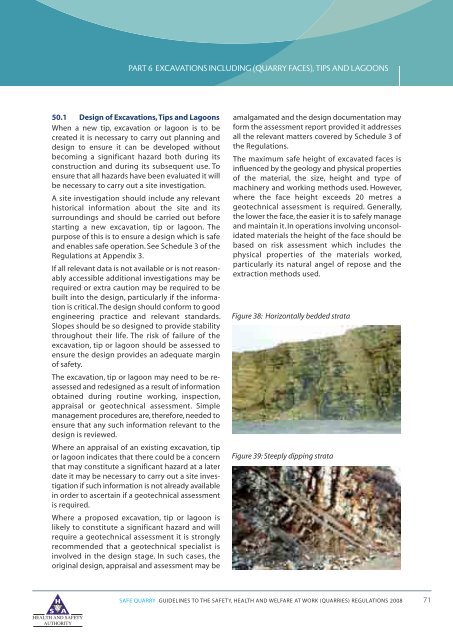Safe Quarry - Health and Safety Authority
Safe Quarry - Health and Safety Authority
Safe Quarry - Health and Safety Authority
You also want an ePaper? Increase the reach of your titles
YUMPU automatically turns print PDFs into web optimized ePapers that Google loves.
PART 6 EXCAVATIONS INCLUDING (QUARRY FACES), TIPS AND LAGOONS<br />
50.1 Design of Excavations,Tips <strong>and</strong> Lagoons<br />
When a new tip, excavation or lagoon is to be<br />
created it is necessary to carry out planning <strong>and</strong><br />
design to ensure it can be developed without<br />
becoming a significant hazard both during its<br />
construction <strong>and</strong> during its subsequent use. To<br />
ensure that all hazards have been evaluated it will<br />
be necessary to carry out a site investigation.<br />
A site investigation should include any relevant<br />
historical information about the site <strong>and</strong> its<br />
surroundings <strong>and</strong> should be carried out before<br />
starting a new excavation, tip or lagoon. The<br />
purpose of this is to ensure a design which is safe<br />
<strong>and</strong> enables safe operation. See Schedule 3 of the<br />
Regulations at Appendix 3.<br />
If all relevant data is not available or is not reasonably<br />
accessible additional investigations may be<br />
required or extra caution may be required to be<br />
built into the design, particularly if the information<br />
is critical.The design should conform to good<br />
engineering practice <strong>and</strong> relevant st<strong>and</strong>ards.<br />
Slopes should be so designed to provide stability<br />
throughout their life. The risk of failure of the<br />
excavation, tip or lagoon should be assessed to<br />
ensure the design provides an adequate margin<br />
of safety.<br />
The excavation, tip or lagoon may need to be reassessed<br />
<strong>and</strong> redesigned as a result of information<br />
obtained during routine working, inspection,<br />
appraisal or geotechnical assessment. Simple<br />
management procedures are, therefore, needed to<br />
ensure that any such information relevant to the<br />
design is reviewed.<br />
Where an appraisal of an existing excavation, tip<br />
or lagoon indicates that there could be a concern<br />
that may constitute a significant hazard at a later<br />
date it may be necessary to carry out a site investigation<br />
if such information is not already available<br />
in order to ascertain if a geotechnical assessment<br />
is required.<br />
Where a proposed excavation, tip or lagoon is<br />
likely to constitute a significant hazard <strong>and</strong> will<br />
require a geotechnical assessment it is strongly<br />
recommended that a geotechnical specialist is<br />
involved in the design stage. In such cases, the<br />
original design, appraisal <strong>and</strong> assessment may be<br />
amalgamated <strong>and</strong> the design documentation may<br />
form the assessment report provided it addresses<br />
all the relevant matters covered by Schedule 3 of<br />
the Regulations.<br />
The maximum safe height of excavated faces is<br />
influenced by the geology <strong>and</strong> physical properties<br />
of the material, the size, height <strong>and</strong> type of<br />
machinery <strong>and</strong> working methods used. However,<br />
where the face height exceeds 20 metres a<br />
geotechnical assessment is required. Generally,<br />
the lower the face, the easier it is to safely manage<br />
<strong>and</strong> maintain it. In operations involving unconsolidated<br />
materials the height of the face should be<br />
based on risk assessment which includes the<br />
physical properties of the materials worked,<br />
particularly its natural angel of repose <strong>and</strong> the<br />
extraction methods used.<br />
Figure 38: Horizontally bedded strata<br />
Figure 39: Steeply dipping strata<br />
SAFE QUARRY GUIDELINES TO THE SAFETY, HEALTH AND WELFARE AT WORK (QUARRIES) REGULATIONS 2008 71
















